
Ascan Pinckernelle
“So (Max) Raphael’s answer to Marx’s problem — why is art enduringly moving even though it merely reflects its social context? — is to say that art doesn’t merely reflect its social context. It does reflect it, because the artist’s material, style, the things they want to represent, even the way they see, are historically conditioned; but it doesn’t merely reflect it, because the transformed material speaks of something deeper and more voluntary. It speaks of humanity’s ability to make its own world, to become the subject and not merely the victim of history.”
Robert Minto (Culture Matters, January 2017 A smuggling operation: John Berger’s theory of art)
“A man’s features, the bone structure and the tissue which covers it, are the product of a biological process; but his face he creates for himself. It is a statement of his habitual emotional attitude; the attitude which his desires need for their fulfilment and which his fears demand for their protection from prying eyes. He wears it like a devil mask; a device to evoke in others the emotions complementary to his own.”
Eric Ambler (The Mask of Dimitrios)
“Since I was a child, I have never liked looking at wax figures. They looked somewhat creepy to me. At that time, electronic prosthetic hands were being developed, and they triggered in me the same kind of sensation.”
Masahiro Mori (interview, IEEE Spectrum 2012)
“And Satan there
Coasting the wall of Heav’n on this side Night
In the dun Air sublime, and ready now
To stoop with wearied wings, and willing feet
On the bare outside of this World.
that seem’d Firm land imbosom’d without firmament”
John Milton (Paradise Lost)
I wanted to start with theatre, and with how I believe theatre is the ur-art medium. Most people will off-handedly assume theatre was born out of religious ceremony. I think the opposite is true. And I want to quote a beautiful article by John Berger on the cave paintings at Chauvet.
“For nomads the notion of past and future is perhaps subservient to the experience of elsewhere. Something that has gone, or is awaited, is hidden elsewhere in another place. For both hunters and hunted hiding well is the precondition for survival. Life depends upon finding cover. Everything hides. What has vanished has gone into hiding. An absence – as after the departure of the dead – is felt as a loss but not as an abandonment. The dead are hiding elsewhere. ( ) The Cro-Magnons lived with fear and amazement in a culture of Arrival, facing many mysteries. Their culture lasted for some 20,000 years. We live in a dominant culture of ceaseless Departure and Progress that has so far lasted two or three centuries. “
John Berger (Portraits)

Evol (Stencil graffiti on utility box, Germany).
Berger captures something of what life was like for a society of arrival. Alone in a world dominated and ruled, really, by animals. But I think he is wrong to assume (though he seems not terribly interested in this) that these cave painters were shamanistic in some fashion or other. I think art came before religion. In one way they are much the same. But these cave painters who came to draw in charcoal, and drew almost entirely animals, suggest nothing religious. They do seem to be asking questions, or not even questions, but they seem to working out what they are, and where they are. But every description of these ancestors seems loaded and wrong. They did not draw when they were hungry. They drew when they had the time to do so. It was likely important. How many came and covered these walls? Or at Lascaux (a full twelve thousand years later) or any of the sites so far found that contain ancient drawings or paintings or carvings. No architecture, no agriculture, but music and art. And the artworks in any of these caves are investigations of space, firstly. Berger knows this. In the darkness (and the earth must have been very dark at night, then) they reflected on themselves, and on others. They watched their children. They watched some die. Nobody lived terribly long. But then nobody knows really. And in the darkness of the night cave they considered themselves. How they came to be adults. And in those reflections were early personal memories. Whatever those memories looked like, they were part of what was drawn on the cave walls.
And fear must have permeated everything. But I suspect their fear was quite different than modern fear.
“Apparently art did not begin clumsily. The eyes and hands of the first painters and engravers were as fine as any that came later. There was a grace from the start. This is the mystery, isn’t it?”
John Berger (Portraits)

Mathew Brandt, photography.
And it was quiet. Dark and silent. And they drew. And if they drew an animal they had seen or hunted earlier that day, or week (and of course there is no way to know how they experienced time, a past or a future) this drawing was both replicating what they had seen…it was a memory…and, it was something else. It was a drawing OF a memory. They had a lot of time to sit and consider how they remembered what they did.
My point is that as they drew, and as they returned to the caves to draw more, or others came to draw, too, there was a sense that these walls were reflecting something of how they navigated the world. And maybe they drew together, in small groups. There must have been conversations and music, at times, and some drawings were preferred and the places where they decorated …often with red dots…might have signaled a group agreement. Was there anything like consensus in these matters? I doubt it, but there was something perhaps vaguely like that. And they saw themselves in the spaces of these drawings. They had a viewpoint. And that viewpoint was a kind of ur-subjectivity. And I would think the music, and a lack of urgent hunger, and something like celebration, fueled discussions. And from such small gatherings, in these caves, came the first story. The first story told to others. And maybe it was a communally created story. But it was theatre. And more important it was theatre space. And it was subjective space made material. Made concrete but never not symbolic, either. There is little indication of inter-communal violence. They had story, and they performed their stories… in some fashion. And they drew horses and bears. And they remembered deaths. And death became something enclosed within this new space of mind.
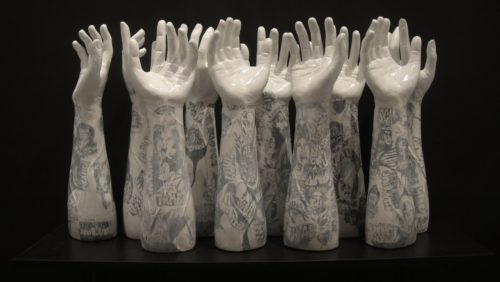
Mark Salvatus
Nothing suggests to me a deity created from this. Maybe there was, but what did that mean to these cave painters? They had story and memory. And in these memories were births and death and sex. There are some drawings in remote corners of these caves, nearly impossible to reach, that must be crawled to, and illuminated with torch. Why were drawings made in such difficult to access places? Again the first ready answer is religious but I don’t accept that. I don’t think the idea of offerings appeared until a priest class appeared.
“These rock paintings were made where they were so that they might exist in the dark. They were for the dark. They were hidden in the dark so that what they embodied would outlast everything visible, and promise, perhaps, survival.”
John Berger (Guardian, Oct 2002)
Now when I imagine the evolution of such things I think that the more complex stories became, and with alphabets and writing, the less direct were the stories, and the more distant — in a sense– was the space. It is like a stencil of character and language and ritual came to be overlaid on the primal space of the first drawing and first person who drew. And this stencil, then, is related to the mask. For the mask is essential to the beginnings of theatre. The essentials, the eyes, are visible in most masks (though not nearly all and that is worth discussing) and children instinctively love masks. One of the chestnuts usually tossed around when the topic of masks is introduced is that wearing a mask allows freedom from who you are. That by wearing a mask one can feel less inhibited. But the opposite is the truth. One must become more who one is when wearing a mask. In terms of theatre the mask encloses character and also hides it, or obscures it. This is the paradox Artaud introduced, that only in that moment of naked terror on stage does the actor truly learn himself. The mask reveals, it doesn’t hide.
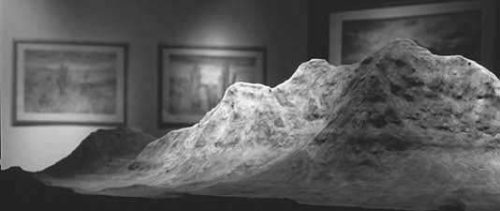
Allen McCollum, in collaboration with Museo Universitario Autonoma de Baja Calif.Mt. Signal .
There is always another mask beneath the first mask. At the end of this process is the cave wall. The mask is like the stencil, then, and the stencil was among the very first techniques used by those early cave dwellers. They, in theory, sprayed pigment from their mouth around their hand which was against the cave wall. The result was the negative image of the hand. Voodoo (and Vodun, or Sanse) employs the spraying of pigment, too, somewhat interestingly.
The space of the stage, which is always shrouded in darkness, an island in the dark, is also linked to grottos and caves. The storytellers use masks. Ancient Greek tragedy was, of course, entirely performed in masks. The island that is the stage is one in which everyone is always wearing a mask, even if that mask is one disguised as the actor who has taken off his mask.
My point here is that whatever the motivations of those Cro Magnon cave artists (if we can even use that word) there was an acute attention and intention to what they drew (Halverson points out that most the animals depicted are those that can be eaten. There are few drawings of animals that might eat the artist). And it is important to note that Altamira and Lascaux were the Sistine Chapels of preshitoric art, and that most of what has been discovered is closer to cartoon doodling. There is, as a final note here, a theory now from linguist Shigeru Miyagawa that echoes some of Leroi-Gourhan’s ideas about cave art and the development of language and writing. Miyagawa’s paper suggests that cave acoustics played a predominant role in where the drawings were made.
“We take up the topic of cave art and archeoacoustics, particularly the discovery that cave art is often closely connected to the acoustic properties of the cave chambers in which it is found. Apparently, early modern humans were able to detect the way sound reverberated in these chambers, and they painted artwork on surfaces that were acoustic “hot spots,” i.e., suitable for generating echoes. We argue that cave art is a form of cross-modality information transfer, in which acoustic signals are transformed into symbolic visual representations. This form of information transfer across modalities is an instance of how the symbolic mind of early modern humans was taking shape into concrete, externalized language. We also suggest that the earliest rock art found in Africa may constitute one of the first fossilized proxies for the expression of full-fledged human linguistic behavior.”
Miyagawa et al (Cross-Modality Information Transfer: A Hypothesis about the Relationship among Prehistoric Cave Paintings, Symbolic Thinking, and the Emergence of Language)
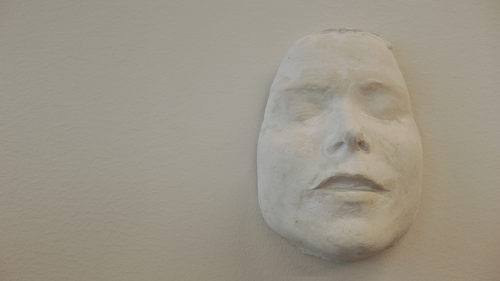
Randa Mdah
Interestingly the quietest spots in the caves are where cats were drawn. And this also, perhaps, suggests why those remote hard to access locations were sites of elaborate drawings.
So this acute attention on the part of those early cave painters is of some importance in an age of degraded attention. If the cyber universe and social media are having deleterious effects on humanity, but especially on the young, then one aspect of this harm is a increasing inability to concentrate, or rather, maybe, to concentrate in ways that produce new ideas or inspiration.
“Many rock art images saliently exhibit features which, at least according to the views held in European cultures, are expressive of aesthetic values such as proportion, quality of line, narrativity, etc., and it is likely that those who made the images paid attention to these values if we find them expressed there.”
Thomas Heyd and John Clegg (Re-Thinking Aesthetics and Rock Art, Rock Art Society of India 2004)
“Art historians with a social or Marxist formation have interpreted the art of the past in terms of class ideology. They have shown that a class, or groups in a class, tended to support and patronise art which to some degree reflected or furthered their own class values and views. It now appears that in the later stages of capitalism this has ceased to be generally true. Art is treated as a commodity whose meaning lies only in its rarity value and in its functional value as a stimulant. “functional value as a stimulant of sensation. It ceases to have implications beyond itself. Works of art become objects whose essential character is like that of diamonds or sun-tan lamps. The determining factor of this development – internationalism of monopoly, powers of mass-media communication, level of alienation in consumer societies – need not concern us here. But the consequence does. Art can no longer oppose what is. The faculty of proposing an alternative reality has been reduced to the faculty of designing – more or less well – an object.”
John Berger (Landscapes)
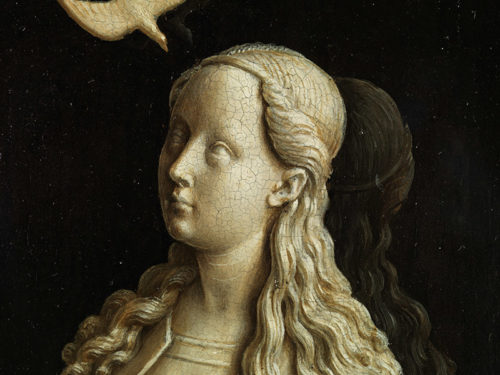
Jan Van Eyck (detail; Annunciation Deptych, 1435).
The Berger quote just above is from a chapter devoted to art critic Max Raphael. And in it Berger notes something relevant to cave paintings and that is the dislocation of space.
“To create pictorial space is to penetrate not only into the depths of the picture but also into the depths of our intellectual system of co-ordinates (which matches that of the world). Depth of space is depth of essence or else it is nothing but appearance and illusion.”
Max Raphael (quoted in Berger’s Landscapes)
Meaningful art is that which disrupts certain continuities (per Raphael) that are assumed. I suggest this has become almost anachronistic today. Partly because the role of cyber conditioning is such that I am no longer sure a majority of the western bourgeoisie have any sense of continuity. Nor of memory, per se. I happened upon the old Maytag commercial (with Jesse White)…the ‘loneliest person …a Maytag washing machine repairman’. https://www.youtube.com/watch?v=rXJ0rAyE_mQ
One would guess this commercial is too complex for today. Too much is only suggested.
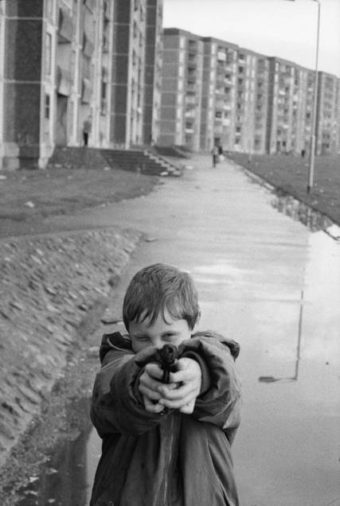
Martine Franck, photography.
“…the Greek word for mask (and face) was prósōpon, which means something like “before the gaze,” and this reflects the mask’s capabilities in acting as an effective material anchor for the projection of a variety of powerful emotional states.”
Peter Meineck (ibid)

Paul Klee (hand puppets made for his son).
It is a personal validation for me to read Meineck’s discussion of masks. For this has been a subject much distorted by academic historians. The mask was never about amplifying the voice, or allowing for the doubling of roles, nor did it in any way minimize the emotional and empathic response of the audience. Quite the opposite in fact.
“…I proposed that theatre is a kind of mimetic mind in that it works because it re-creates and represents the cognitive processes of its audiences. The way in which dramatists create theatrical worlds on stage is an enacted replica of the generative predictive model, where our attention is focused on visual or aural information that builds a cognitive picture of a scene.
Like the ambiguous mask, less is very often more in the surrogate environment of the theatre, as our evaluative systems need only the merest of information to start to actively generate the inferences we need to make sense of what we are experiencing.”
Peter Meineck (ibid)
Murray Mednick used to say, theatre is a form of thinking. It is also the re-creation of a primal space in which our first developmental steps are taken as infants. The primal scene is the formation of our subjectivity. There is an interesting sort of side bar discussion Meineck has in a chapter on empathy and mimesis. The term “emotional contagion” is used. And a Facebook survey is even mentioned. I will only add here that the alarmism of much journalism today, especially regards climate change, is spreading an emotional contagion. The veracity or not of said topic is subsumed by the spreading of this contagion. What Reich called, in another context, the ’emotional plague’. Now, the enduring danger that theatre represents to the authority structure, has eroded but not disappeared. The danger is simply built into the elements of a stage space. And the key is this idea of *space*, or perhaps more precisely *place*. But place means both image and text. Theatre itself means going to watch place. It is worth mentioning at this point Masahiro Mori’s idea of the *uncanny valley* (and that essay is finally, several decades late, available in English here…https://spectrum.ieee.org/automaton/robotics/humanoids/the-uncanny-valley )
There are elements in Mori’s essay that are perilously close to Von Kleist’s famous essay on marionette theatre from the 18th century. What is telling about Mori’s theory is that the Spectacle has been normalizing this form of uncanniness now for thirty years, Id say. It was Plato who warned of a government of spectators.
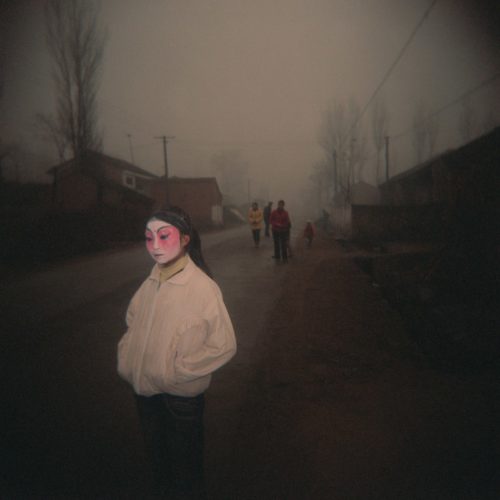
Zhang Xiao, photography.
The normalizing has been with respect not just to image but to computer generated voices. It is a society increasingly conditioned to accept technological uncanniness, to even desire it. The erosion of the ability to read faces, to process the micro expressions of the human face is documented.
“Difficulty decoding the emotional signals generated by the face is one of the major indicators for people on the autism spectrum, and it can be incredibly socially debilitating. As much as humans depend on facial processing to try to comprehend the thoughts and emotional states of others, a significant marker of normal cognitive development is our ability to display emotions that contradict our true emotional state. To know just the right time to feign a frown or a smile is a crucial part of normal human social interaction. This is a basic aspect of mind/body dissociation connected with Theory of Mind and empathy.”
Peter Meineck (ibid)
People have come to more and more expect and prefer cartoon versions of everything, not just faces. Schematic renderings of famous people are recognized more readily than photographs of that same celebrity. And this is to be expected, but more disturbingly the cartoon or schematic is preferred now in narrative and in image. Complexity in all respects is eschewed and viewed negatively. This ties into the flaws (which should be obvious) with facial recognition technology. And the only reason that technology works at all is because people increasingly act and appear like robots.
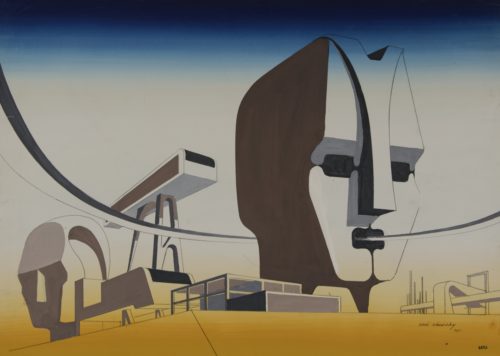
Xanti Schawinsky
And of course the lost face of the parent. Lost or frozen. The face of inattention. The inattention is connected on a sort of primary level with loss of empathy. And here, again, art reflects much of this. And entertainment. And the loss of intentionality. And here I might note Derrida’s influence, mostly bad, in which intention is simply discarded during critical analysis of the text. The word. And without digressing too much here, I think the loss of intentionality is entwined with a bad faith elevation of chance as an aesthetic strategy. The reverence for virtuosity that claimed preeminence mid 20th century, the philistinism of post WW2 America gave way to a kind of contempt for craft and certainly a disdain for seriousness.
Now, returning to theatre, and to the stage, I was reminded of T.J. Clark’s analysis of Jackson Pollock. I don’t think anyone ever wrote as beautifully or correctly about Pollock. (see Farewell to an Idea). But one point he made was that Pollock worked incessantly against metaphor. And without getting into this in any detail one point Clark made was that it wasn’t just the abstraction. For…to quote Clark…“A painting could very well be purged of all traces and afterimages of likeness, in the way Fried celebrates, and still not do the work
against metaphor I have just been describing. We could have – I think we do have – a strictly “optical,” anti-figurative abstract painting which all the same stood in a reiterative relation to the imaginary orders of a world we think we know. An inert relation, Pollock would reckon. A relation to Nature, for instance, in which nothing of that dismal category was put under pressure.”
This is important. For, firstly, everything has a narrative. And second, it is the careful intentionality of Pollock that creates this terrifying truth. It is why to stand before a major Pollock means something. There is a clear intuition in the viewer (to quote Clark again) “that it so resists a viewer’s effort to have it be like even the modes and qualities of a mineral or vegetable world.” Nature is reached by its removal. It is a terrible sort of power to achieve that (which is why Clark quotes Milton on that page).
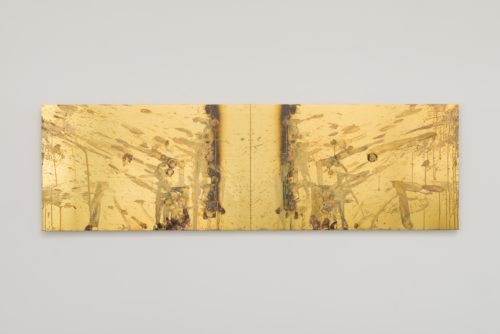
Reijiro Wada
“In the 1950 paintings, Adorno might say, the poles of metaphor tend to split apart and simplify. On the one hand, the figures of dissonance become schematic, black and white: dissonance recognizes itself as mimesis, as handwriting, as theater of some sort: it is extracted from the mix of sensuousness. Number 32, 1950 is the prime example. And on the other, Nature returns – Lavender Mist, Autumn Rhythm, One – metaphors whose very breathing completeness carries within it the sign of a practice coming to an end.”
T.J. Clark (Ibid)
Handwriting, just as the paintings at Chauvet or Lascaux. Clark wrestles with Abstract Expressionism, even as he steadfastly defends it. And the defense is really summarized in the sentences below.
“What remains to be thought about Abstract Expressionism, (though the thought haunts everything written on the subject, especially those texts most anxious to repress it) is the painting’s place in a determinate class formation.”
(ibid)
Clark also notes that the strongest readings of Pollock came from gay men. Frank O’Hara and Beaton and Parker Tyler. It is an interesting observation. That somewhere in this clear potency of Ab Ex work is a homoerotic hero worship. Perhaps. Now I think there is another aspect to what Clark is saying regards Pollock (in particular). And which others noted, too (Parker Tyler for one). And that is that for all the sexual energy in his work, there is an immutable sense of death. And that is what happens when Nature is removed. Consciously removed from any cultural expression. And I should note here my fondness for Louise Nevelson’s work. For Nevelson is the most funereal of artists. Her work is formally about ends and loss. Or, more, about funerals exactly. Pollock’s is not. But death haunts his work. And this is not biographical projection I don’t think. But whatever one thinks regarding the absent metaphor in Pollock, the theatre of the modern era has had only a bare handful of really important artists. And all of them are working to find their way to place of our psychic formation, but also to the history of our social formation. And this relates to Clark on Ab Ex and its determinate class formation.
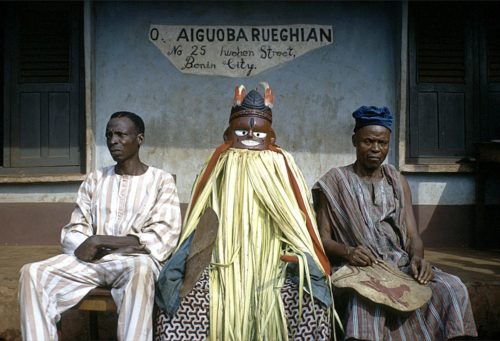
Ighogho masquerade, Benin City, Nigeria. (maybe the 1970s)
Genet, Handke, Pinter, Bernhard, and Beckett are certainly the first tier of importance. There are a number in the second tier; Kantor, Muller, and Brecht. And its likely any of those …and probably Brecht…belong in the first tier (or as Andrew Sarris used to put it, the pantheon). But I am speaking specifically about theatre. Handke is a great novelist, Genet, too, Brecht a great poet, and so forth. But theatre is different. There are few works or performances that are not tainted with either the specter of film, or the shadow of entertainment. And worst, the naturalism of representation. But theatre is a textual form in my opinion. It does not exist without speech spoken aloud. Recitation, and here the repetition complex found in much modernist painting is mirrored in theatrical performance. There are a dozen very smart playwrights who have ideas and facility. David Hare is a consummate theatre technician and a writer of great almost unimpeachable clarity. But his plays are bourgeois in form, regardless if the content is not. Look at The Screens, or Kaspar Hauser. Or The Homecoming. They are finally plays both about themselves as theatre (meaning, much as Clark imagined Adorno talking about Pollock and mimesis, there is a difficult or perhaps impossible balance between resisting bourgeois-ification, and metaphor — the search for reconciliation which cannot be found, finally). But the impossible is not the same as failure or valueless. That recognition itself is a rejection of capitalism.
The best, or among the best productions of Shakespeare I ever saw was a Junior High production of Comedy of Errors. While that’s a glib comment, I mean it sincerely. It was much edited down but done with perfect sincerity and great commitment. It was also barely *acted*. It was more or less recited, but recited with young voices and without commentary. This is the conundrum, or paradox of western art overall since the Enlightenment. The representation of the world as overcoming, or as defeat. We don’t have the same set of problems with Dante or Shakespeare. The point I am struggling to get at is one that is illuminated by a close reading of those ancient cave paintings, and one being foreclosed by contemporary western society. The Capitalist cyber system of domination and erasure.
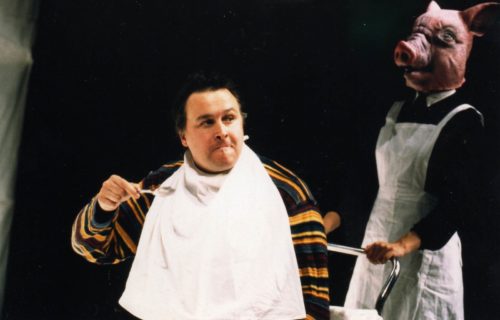
A Party for Boris, by Thomas Bernhard. Teamtheater Munchen 2000.
“This Derridean vision of ‘arche-writing’ encourages one to react to any linguistic message, indeed to each part of it, as one would to a scrap of paper found on the street…”
Louis Sass (Madness and modernism : insanity in the light of modern art, literature, and thought.)
Even a conservative such as Ortega y Gasset could write of a tendency in modernism that would end in merely the ironic. And this because of a growing chasm between experience and solipsistic narcissism. It is possible, then, too to look at theatre, and all arts today, in the terms that Tarfuri set for architecture. In fact the final endgame for architecture under Capitalism was the Seagram’s Building of Mies Van der Rohe. It encapsulated the frozen death grip of capital and expressed the (perhaps) final logical cul de sac for architects today. Only a revolution could actually change architecture.

375 Park Ave. (Seagrams Building) Mies Van der Rohe, architect.
https://www.counterpunch.org/2019/05/23/a-new-volkisch-mythos/
The sensibility of the Bismark entry is, beyond the Berghof affect, a strange bit of self satisfaction. But then the fascist ethos is always self congratulatory. So Tafuri is right, basically. And if extrapolated out from architecture, the Seagram’s building becomes to architecture what Ayn Rand is to literature, or Frank Capra to film. And that’s no doubt unfair to Capra. Think perhaps John Ford, because after all the Seagram’s building is not hack work. Its a remarkable piece of architecture and in some ways, despite the accompanying shudder, it looks better today than a century and a quarter ago. The seemingly indestructible imperishable and nearly omnipresent sense of fascist style today, a style carried forward from the 1890s probably, is testament to something that has dulled the soul, has incessantly traumatized society and left lingering suppurating wounds. The logic of Seagrams is the logic of facebook, finally. And it is the logic of Joe McCarthy, Boris Johnson, or Trump. Trump tower is only the 3rd generation dupe of Seagrams.
And this loss of intention and concern for what one creates is expressed also in the identitarian solipsistic hubris and navel gazing of probably 80% of what MFA programs turn out in fine arts and theatre. Lucian Smith is pretty much the same as Rachel Kushner or Yazmina Reza. The dialectical posturing of feigned hate; fashion designers boycotting fashion week because the location is owned by a Trump supporter. Vera Wang and Michael Kors and whoever are already cannibalising the carcasses of whatever lies in the dumpster behind Mar a lago.

Mauro Piva
“It should be stated immediately that I do not believe it to be by mere chance that many of the new and recent ideas on architecture have been gleaned from an accurate reexamination of the origins of the historical avant-garde movements. Going back to these origins, situated precisely in that period when bourgeois ideology and intellectual anticipation were intimately connected, the entire cycle of modern architecture can be viewed as a unitary development. This makes it possible to consider globally the formation of architectural ideologies and, in particular, their implications for the city.”
Manfredo Tafuri (Architecture and Utopia)
This is also true of political formations. Ideology is always political but the unitary development of fascism, as it is seen growing today, again, is connected to the Berghof or Villa Torlonia, and then extends back to the Roman Senate. I don’t know. The Apple campus in the shape of a flying saucer or hoola hoop. But there is a curious shift today as the ruling class now pay for the removal of electronic gadgets, they pay and express their privilege with conspicuous lack of consumption. Which is, needless to say, its own shell game, too. For they consume a great deal in not consuming conspicuously.
“When engaged in communication with another, the face is in a state of almost constant movement.”
Peter Meineck (ibid)

Deborah Turbeville, photography (For Comme des Garcons perfume)
“But the prison, precisely because infinite, coincides with the space of human existence. This is very clearly indicated by the hermetic scenes Piranesi designs within the mesh of lines of his “impossible” compositions. Thus what we see in the Carceri is only the new existential condition of human collectivity, liberated and condemned at the same time by its own reason. And Piranesi translates into images not a reactionary criticism of the social promises of the Enlightenment, but a lucid prophecy of what society, liberated from the ancient values and their consequent restraints, will have to be. “
Manfredo Tafuri (ibid)
And Piranesi is then Thomas Bernard or Ionesco or Herbert Blau. For it was Blau who repeated so often the impossibility of theatre. And Piranesi is then to drawing and architecture what Sirk is to film.
The atrophy of human movement is related to screen harm and habituations. The atrophy is also a kind of distortion, for what movement remains is one that imitates robotics (the uncanny valley will soon not matter).
“What the neuroscience community is finding is that our cognitive abilities to imitate, learn, speak, understand, and empathize are linked to embodiment—our minds and our
bodies are connected in experiential cognition and we process the emotion of others through a system of “action representation.” Thus, “we ground our empathic resonance
in the experience of our acting body and the emotions associated with specific movements.” It follows that what I term “symporeia” or “collective movement” has a particular
role to play in human cognition and emotional intelligence, beyond its usual role of creating social cohesion and reinforcing group identity. In neural terms, movement is the essential interpersonal communicator of emotion and empathy.”
Peter Meineck (The Neuroscience of the Tragic Mask)

Peter Mitchell, photography.
The solipsism and political amnesia of what is conventionally labeled post modernism is, perhaps, just the effects of several generations of screen habituation, and the transformations in cognitive processing, the erosion of face to face communication, and the isolation of lives lived on the internet. That and a direct encouragement from the US government to promote the most a-political and vapid pretentious pseudo theory — largely French as it happens — to direct studies away from Marxism. And that, too, alongside the entertainment industry that promotes anti intellectualism on all fronts.
A final thought on the legacy of the Enlightenment. One definition of the Gothic or Supernatural (and I think this was Vijay Mishra, but it doesn’t matter really) was that it was an absence of structure. That this loss invites solutions of a magical sort. The loss of rational science that seemed to go alongside the embrace of postmodern thinking — if one agrees that it did — suggests that it was tending toward an allowance for magic and even a return of gothic fantasy. Its possible to see Harry Potter in this light. And the rise of a new faux Catholicism in Hollywood — from The Exorcist to the DaVinci Code. This is nostalgia for a certain ceremonial grandeur. This sensibility even bleeds into an explanation for the popularity of The Godfather (per last post). My point is only that as anti rationalism took hold over the last forty years, what I might call the NEW anti-rationalism, it found kitsch expression in Hollywood, but it also found traction in politics and fine arts. This extends, too, to new age practices, the Yoga studio and health food store. The de rationalization of the western white bourgeoisie is now a normative belief. And it often, if not usually, a casual magic. Magic offered as an aside. Americans, as Martha Rosler once said, prefer the fake. And they prefer the fake to normalize the loss of abilities to read and criticize culture. The deadly theatre (per Peter Brook) that now inhabits the stages of major regional theatres and equity houses in major cities of the U.S. is the identitarian pablum that safely puts one to sleep. The pulp Inquisitional gothic of Dan Brown et al is the flip side of this. And cutting through all of it is a sneaky worship of and nostalgia for royalty and the trappings of Victorian wealth, and for the ersatz romance of colonialism. An intellectual mechanism that also serves to neutralize the idea of cruelty as an evil. The loss of empathy and literacy is increasingly finding popular expression in period atrocities, lovingly re-recreated.

Ralph Eugene Meatyard, photography.
to donate to this blog you can use the paypal button at the top of the page. Many thanks to those who have, and to those who might.

That first quote makes me nuts. It’s the old Gambit where some one relying on a lib inodlcrinated audience unfamiliar with Marx attributes a dumb throwaway exaggeration of Heideggers or Nietzsche to Marx, then says Marx was wrong and then plagiarizes Marx stating the obvious as of he originated this thought, ascorrective. It was Marx who said men make their own history but in conditions inherited from the past. It’s Nietzsche heidegger and Schmitt and Hitler and goofballs everywhere who insist everybody but the aryan Supermen is a mere robot run by the historico- racial programme and nobody has had an original thought since the preSocratic Greeks. Marx was the ferocious opposite of a malthusian or benthamite while all these anarchoid aristos were crypto malthusian.
That said: The Herzog movie about Chauvet is beautiful and avoids attributing the Nazi hegelian schedule . it’s interesting to see the shift from the Chauvet perspectives and style to the panoramic becoming-cartograpohy of the later caves. tho this could also be atypical contrast of styles instead of indications of epochal change of mentality and aesthetics. But it certainly fits what we know what actually happening socially. A subtly transformed cosmology To bring individual consciouness up into relief as a rival principle …makes sense. A compelling guess.
Semi sequitur I’m noting the absence of Pirandello in the pantheon. Unexpected. Important but quite strange and feeling less resolutely modern than ambivalently antimodern, the true fascist schizy. Adorno detects this in all modernism — as Moretti reminded everyone the frankfurts saw modenism as symptom of, not negotiation with, something really awful whose ultimate form is fascism — but in Pirandello there is the overt populism as a theatrical duty that he shares with Brecht from opposite political conceptions , and which puts them both at an angle to the typical practises of absurdism which require and anticipate cultured educated audiences with social clout and conscious aesthetic programmes, subtended by lib democracy and capital. We can say Pirandello fails in his populism but we see him really try at the risk of genuinely putting off his elite audience , not in the pseudo offensiveness of titillation and naughtiness but just by losing their interest. Brecht still has the capacity to offend. in the Mahagonny revival at the Met in the 90s which was superbly sung and staged audience portions walked out huffily noisily in the middle of the performance . Pirandello still has the capacity to bore to death.
The theatre in the space and the nature of this space and Nazism/fascism…I was recently reading about Charlemagne — the “Father of Europe” — and this huge huge atrocity he committed in the Christianizing project that later became the mythohistoric form of grievance for Nazis. The massacre of the Saxon pagans at Verden and the destruction of their sacred tree and grove. (it occurred to me that this is the base material of Avatar via the Nazi mythofable). Charlemagne slaughtered 5-10k Saxons in one day. In the 20th century The SS met at the Sachsenhein the supposed site of this massacre, read as an ultramontane conquest ultimately due to the judiaziation of the Germanic tribes effected by the dupes of Jesus. Its striking me as funny and curious these parallel retreats to the sacred wood we also see in the theatre movements Blau chronicled and which Andre Gregory narrated very successfully with movie audiences in My Dinner With André, which tried to create a utopian de-tribalized and communistic return and ricorso of community and theatre. This Sachsenhein ritual spot is a kind of pendant of theatrical modernism , two reactions to the bourgeois theatre and the church as theatre, and now with Avatar and all this fascist product — the cgi unleashed its current form — it’s like the specialized spectacle place is reabsorbing the repudiated origin in an ersatz form, as canned commodified essence. It struck me that th last / latest real soap opera Downtown Abbey does this too… downtown Abbey the estate is two kinds of theatre, the Saxon grove druid scene as commodified Authenticity and the vaudeville/sitcom, fusing. This gives it is Nazi feel despite running all the traditional soap programme formulae which are classic liberal prog democratic populism. The cgi is the material means of the commodification of this sacred rival.space
I think that idea of Downtown Abbey as another example of this splitting (i mean i guess that is obvious… I don’t know) is very perceptive. In fact that show is splitting all the time, starting with the title and faux class analysis. But the style, the acting, is very carefully modulated. And I think this is not even conscious. Its actors sensing where to find their light. Now with Pirandello I guess I just find him tedious. I thought about Ionesco who likely deserves to be there. And Athol Fugard who does too. Fugard and that original troupe…zakes mokai (who I met and tried to get to do a play at the Taper…but alas I think he wasn’t well)…and John Kani and Winston Ntshona, that was remarkable work, and remarkably radical in form. You can even look at still photos of those performances and sense this.
I had some problems with Herzog, as I always do. But he fell into this (what I see as a) trap with suggesting a small shrine. Religious explanation is so deeply engrained in the West. It is just there, always. Oh it was a god…or a shrine…or a temple. I doubt this very strongly. Why would cave painting cro magnons invent shrines? What does that mean? but its a very facile way out of a conundrum. Herzog does it offhandedly because I suspect he knows its not really a very deep analysis. As for Chauvet and then 12 thousand years. …. that is so hard to think on. Its so hard to know….but they keep finding more caves and sites with early painting or drawing. And it starts to feel as if everywhere at once man…pre man…passed through this evolutionary portal….and everything changed. Humanity arrived. They entered stage left. I mean that is how it seems, all theatre.
As for that first quote….i think this is where we literally live in alternate universes. Ill leave it at that.
But Berger was certainly not a hegelian nazi. I do think its very very hard to talk about this cave art. The Leroi Gourhan stuff remains very useful I think. About gesture and speech. And how gesture is tied into cave art…and into the evolution of language and speech and text.
wait but WHERE did marx ever say art merely reflects its social context? he never said anything of the sort. he was very keen on art and sensitive to it. It’s just false. Nieizsche and Heidegger and all these crazies said shit like that but Marx never did.
about Herziog i guess i ignored that i was so mesmerized.
Marx just repeatedl described the social relations of class society that suppress art and limit (as well as enable) and impact art and wanted to liberate everyone from the division of labour that excluded most people from art and everything else the flourishing human is capable of:
“The exclusive concentration of artistic talent in particular individuals, and its suppression in the broad mass which is bound up with this, is a consequence of division of labour. Even if in certain social conditions, everyone were an excellent painter, that would by no means exclude the possibility of each of them being also an original painter, so that here too the difference between “human” and “unique” labour amounts to sheer nonsense. In any case, with a communist organisation of society. there disappears the subordination of the artist to local and national narrowness, which arises entirely from division of labour, and also the subordination of the individual to some definite art, making him exclusively a painter, sculptor, etc.; the very name amply expresses the narrowness of his professional development and his dependence on division of labour. In a communist society there are no painters but only people who engage in painting among other activities.” (Grundrisse)
ok, I mean I stipulate that Minto is a moron. But this is a bit of letter of the law vs spirit of the law. The import of that quote is obvious. So yeah, duly noted. If nothing else strike the word merely. Here is the article in its entirety https://www.culturematters.org.uk/index.php/contributors/itemlist/user/693-robertminto
And marx said a lot about art, over the course of his life, much of it contradictory.
“It follows from what has been said that the designation of labour as productive labour has absolutely nothing to do with the determinate content of the labour, its special utility, or the particular use-value in which it manifests itself.
The same kind of labour may be productive or unproductive.
For example Milton, who wrote Paradise Lost for five pounds, was an unproductive labourer. On the other hand, the writer who turns out stuff for his publisher in factory style, is a productive labourer. Milton produced Paradise Lost for the same reason that a silk worm produces silk. It was an activity of his nature. Later he sold the product for £5. But the literary proletarian of Leipzig, who fabricates books (for example, Compendia of Economics) under the direction of his publisher, is a productive labourer; for his product is from the outset subsumed under capital, and comes into being only for the purpose of increasing that capital. A singer who sells her song for her own account is an unproductive labourer. But the same singer commissioned by an entrepreneur to sing in order to make money for him is a productive labourer; for she produces capital. Theory of Surplus Value, addenda.
And the point is that art transcends the social context in which it was made. And in some cases that is strangely inexplicable and in others sort of banal.
But he’s saying productive of capital for a capitalist not of use values.
He takes the example of Milton to emphasize how odious and criminal and evil and deadly is the mindset of political economy and capital. Because everybody knows Paradise Lost is a masterpiece that enriches all humanity
It’s an essay explaining what polieconAdam Smith abshis kind meant by “productive labor” and how evil and poisonous their system is: ” labour is only an abbreviated expression for the whole relation, and the manner in which labour capacity and labour figure in the capitalist production process. Hence if we speak of productive labour, we speak of socially determined labour, labour which implies a very definite relation between its buyer and its seller. Productive labour is exchanged directly for money as capital, i.e. for money which is in itself capital, has the quality of functioning as capital, and confronts labour capacity as capital. Productive labour is therefore labour which for the worker only reproduces the previously posited value of his labour capacity; but as value-creating activity it valorises capital, and counterposes the values created by labour to the worker himself as capital. The specific relation between objectified and living labour, which makes the former capital, makes the latter productive labour.
The specific product of the capitalist production process, surplus value, is only created through exchange with productive labour. What forms its specific use value for capital is not its particular useful character, any more than it is the particular useful qualities of the product in which it is objectified, but its character as the element that creates exchange value (surplus value).
The capitalist production process is not merely a process of the production of commodities. It is a process which absorbs unpaid labour, making the means of production into means for the absorption of unpaid labour.
It emerges from what has been said so far that to be productive labour is a quality of labour which in and for itself has absolutely nothing to do with the particular content of the labour, its particular usefulness or the specific use value in which it is expressed.
[484] Labour with the same content can therefore be both productive and unproductive.
Milton, for example, who did Paradise Lost, was an unproductive worker. In contrast to this, the writer who delivers hackwork for his publisher is a productive worker. Milton produced Paradise Lost in the way that a silkworm produces silk, as the expression of his own nature. Later on he sold the product for £5 and to that extent became a dealer in a commodity. But the Leipzig literary proletarian who produces books, e.g. compendia on political economy, at the instructions of his publisher is roughly speaking a productive worker, in so far as his production is subsumed under capital and only takes place for the purpose of the…”
Marx is explicating political economy which he shows is a pseudo science in the servie of an abominable social evil, and explaining in detail excatly how evil that social evil is, and how it wounds humanity. The reason he chooses Milton and Paradise Lost there is the apodictic greatness of the work and the additional striving political and spiritual character of it; its with his characteristic sardonicism he says Milton was unproductive (according to Political economy) this is supposed to make the depravity of poliecon obvious without his having to say it because he refuses ever to moralize against capitalism. But Paradise Lost it is an example of so many values to which capital is indifferent and capitalist evaluation is indifferent (aesthetic, moral, psychological, national, religious/spiritual, some revered by Marx others not) and which capital as a relation and mode of production thus destroys.
“Here we should like briefly to anticipate our results, before we consider any further the changed shape of capital which emerges as a result of the capitalist mode of production.
Since the direct purpose and the actual product of capitalist production is surplus value, only such labour is productive, and only such an exerter of labour capacity is a productive worker, as directly produces surplus value. Hence only such labour is productive as is consumed directly in the production process for the purpose of valorising capital.
From the simple standpoint of the labour process in general, such labour appeared to us to be productive as was realised in a product, or more precisely in a commodity. But from the standpoint of the capitalist production process, this element has to be added to the definition: such labour is productive as directly valorises capital, or produces surplus value, hence is realised, without any equivalent for the worker, for the performer of the labour, in a surplus value, expressed in a surplus produce, hence in an excess increment of commodities for the monopoliser of the means of labour, for the capitalist; only such labour is productive as posits the variable capital, and therefore the total capital, as C + DC = C + Dv. It is therefore labour which directly serves capital as the agency of its self-valorisation, as a means to the production of surplus value. “– Marx https://www.marxists.org/archive/marx/works/1864/economic/ch02b.htm
?That worker is productive who performs productive labour, and that labour is productive which directly creates surplus value, i.e. valorises capital.
[481] Only the narrow-minded bourgeois, who regards the capitalist form of production as its absolute form, hence as the sole natural form of production, can confuse the question of what are productive labour and productive workers from the standpoint of capital with the question of what productive labour is in general, and can therefore be satisfied with the tautological answer that all that labour is productive which produces, which results in a product, or any kind of use value, which has any result at all.” eom the point of view of the bourgeois, he shows, even Milton was unprductive: he is saying this because the bourgeoisie of the time could be imagined to be horrified to be accused of this, but he is not moralizing he is treating them and their politican economsts with contempt.
um yes, i know.
So why so you say that contradicts anything else he wrote about art? What does it contradict?
i dont know what you are referring to. I didn’t say anything was contradicted by anyone etc. Where have i said that?
but have you not made your point yet? Regards that quote?
John can you please transport me to whatever universe you’re living in, where Warren is the heir apparent of The Establishment, Greta Thunberg has any power over anything, and the Green New Deal has a snowball’s chance in hell of happening? I’m tired of living in Trumpworld, I’ll happily switch places.